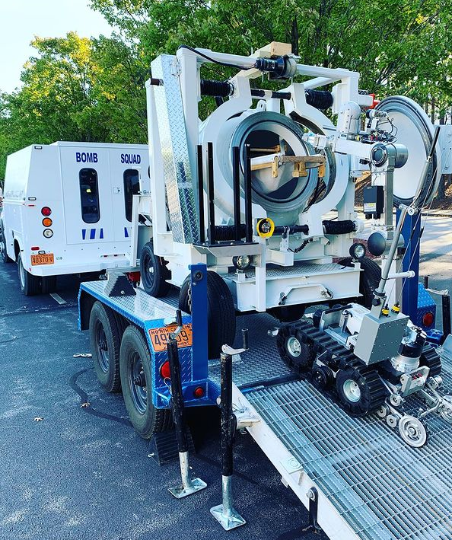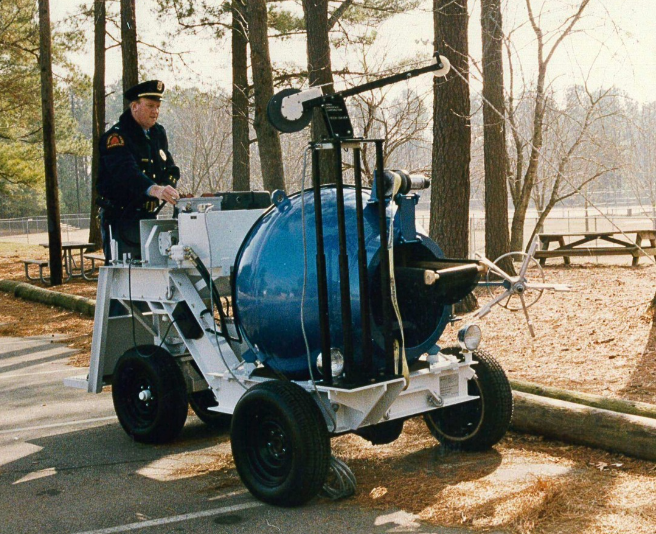
Evolving from the pandemic, the term “remote work” has become synonymous with employees working from home as a protocol, fashioned to preempt exposure to deleterious conditions. For cops, staying home is not necessarily an option when calls for service require a response, especially when reports involve enormous perils engendering catastrophic potential.
Law enforcement officers conduct police work at incident scenes. However, certain circumstances dictate distance as a safety feature, with cops safely operating/assessing from a peripheral place to gain a perspective regarding dangers and such…thanks to the advent of robotics and electronic marvels enabling a closer look without sending humans into an abyss of unknowns.
A glaring illustration of our topic today is when police agencies receive reports of a “suspicious package” which may be an explosive device wired for destruction. Similarly, malice-minded individuals skilled in fashioning bombs, emplacing them, endangering the public, and decimating property stemming from anger directed at some facet of society, must be carefully considered.
As our society advances in the realms of AI and robotics, law enforcement organizations have equipped themselves with sacrificial apparatus to thwart people hell-bent on blasting to get their point across.
Dipping into the realm of police bomb squads, belt yourself in for a ride-along with these specialized law enforcement professionals:
“The NYPD Bomb Squad is equipped with everything from high-tech robots to specialized bomb transport vehicles to help highly trained officers respond to threats quickly and effectively. Here’s a close-up look at the vessel used to transport the device found at 27th Street on Saturday safely out of the city,” explained a bulletin from 2016.
Naturally, technological advancements enable cops to stay put while remotely working mini tank-like engineering marvels, essentially sacrificing the machine and keeping humans from harm’s way. Along the course of careful recovery of any explosive devices, the tiny tanks on tracks transport the bomb to the TCV mentioned in the brief video above.
The Raleigh Police Department in N. Carolina posted a combo shot, illustrating one of their mini tanks coursing up the ramp, simulating carefully carrying a would-be bomb to its total containment vessel, after which it is driven away to a desolate place for detonation.

(Photo courtesy of the Raleigh Police Department’s Hazardous Devices Unit.)
Raleigh Police recently posted some of its Bomb Squad antiquity. The difference with the following image when compared to the one posted above is the police officer operating a Zamboni-style bomb containment vessel, circa 1997.

(Photo courtesy of the Raleigh Police Department.)
How far we’ve come…much more remote nowadays.
Robo-Dog
The NYPD added a dog-like robot to its fleet of accessories relegated to police work, safeguarding human counterparts who work the robo-dog remotely. Painted thin-blue-line blue and black and equipped with lights and a camera system, here is the NYPD’s “Digidog”:
It didn’t go over well with some members of the public who felt it could be an invasion of privacy. The NYPD brass pulled Digidog after ample backlash from citizens.
Anti-police NYC Council members wanted Digidog gone. Rep. Alexandria Ocasio-Cortez reportedly had a conniption over Digidog.
According to ARS Technica, “The department described the robot as a tool that could be used to defuse dangerous situations and said it would help officers stay out of harm’s way. In an environment where critics question the amount of resources police departments are given, having a state-of-the-art robot dog patrolling the streets of NYC drew a lot of negative attention and viral videos.”
On the heels of Digidog finding itself in the crosshairs of some, John Miller, then-NYPD deputy commissioner for intelligence and counterterrorism, said, “People had figured out the catchphrases and the language to somehow make this evil.” Imagine that!
In an environment rife with anti-police volatility and abject disrespect for law and order, one can easily imagine police robots in Gotham getting treated no better than human counterparts in blue uniforms, the real evil picking on perceived evil.
Some grown-ups might not know better but children ordinarily do, as seen in this brief footage illustrating a young boy afflicted with cancer, whose day was illuminated when a group of cops from the Houston Police Department put on an exposé for the youngster, thus putting smiles on his face.
“The smile on his face was worth it,” Houston Police SWAT Officer B. Hollis said. “Operating a robot and a ride in the armored vehicle made for a memorable day!”
Little Julian had his hands on tons of police gadgets, even operating a remote-controlled tiny tank deployed in certain high-risk incidents responded to by police.
Despite the backlash over Digidog some time ago, the NYPD re-implemented robot dogs for some of their police work. Technical Assistance Response Unit (TARU) officers are trained in the remote operation of robotic canines and deploy for incidents considered hazardous to human counterparts.
The NYPD’s TARU cops are also licensed to operate the police force’s drones.
Unmanned Aerial Vehicles
More commonly known as drones, modest-sized remote-controlled unmanned aerial vehicles (UAVs) have become more popular among law enforcement agencies, finding a police role in various ways, all to their advantage (officer safety).
Given thickets and forested areas that law enforcement officers realize they must navigate for either a missing person or fugitive who just ran from justice and is hunkered down in heavy foliage or swampy terrain, drones suit the bill and carry out the duty on the fly.
“As the largest municipal police department in the United States, the NYPD must always be willing to leverage the benefits of new and always-improving technology,” said now-former Police Commissioner James P. O’Neill. “Our new UAS program is part of this evolution – it enables our highly-trained cops to be even more responsive to the people we serve, and to carry out the NYPD’s critical work in ways that are more effective, efficient, and safe for everyone.”
An NYPD TARU bulletin explained: “This cutting-edge technology is another tool that the NYPD can deploy in select circumstances to help keep New Yorkers safe and enhance officer safety. The UAS program can help NYPD gather crucial information as situations unfold without putting officers at risk and lessen harm and danger to civilian bystanders and other involved parties.”
Akin to satellites, only much smaller, drones have incredible buoyancy, provide real-time high-resolution imagery, and can detect things from above that otherwise may not be available to the eyes of ground forces. If over bodies of water, the investigative dilemma is worsened for humans but drones have free reign from overhead positioning (like police helicopters, only far more cost-effective and without inherent perils since humans are not on board but working remotely).
One of the last major investigations I was involved in before police retirement was of a businesswoman who went missing (her vehicle in her wide-open garage, her house unsecured, many house lights illuminated, her keys and cell phone left on a table).
Missing Persons/Homicide detectives teamed up and focused on her former boyfriend from whom, we learned, she sought a break-up. He had acres of land in a rural area. With warrant in hand, a search team was assembled and covered tons of terrain over several days; a drone would have trimmed the time down significantly and even provide recordings for potential future use. This was before the advent of drones used in policing.
Remote-controlled devices have proven instrumental in some major capers, too.
South of me, the Lee County Sheriff’s Office “expanded the agency’s fleet of drones. We now have an underwater drone, Black Hornet drones, and the Dragonfish Drone” often “utilized in many different […] functions including missing persons investigations and apprehensions.
Remember the big case involving Brian Laundrie that made national news for several days?
According to Lee County Sheriff Carmine Marceno, “This drone was even used to assist the North Port Police Department [whose jurisdiction encompassed the home of Laundrie’s parents who were suspected accomplices] and the Federal Bureau of Investigation in their search for Brian Laurie.”